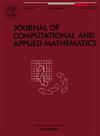Domain decomposition with local time discretization for the nonlinear Stokes–Biot system
IF 2.6
2区 数学
Q1 MATHEMATICS, APPLIED
Journal of Computational and Applied Mathematics
Pub Date : 2024-10-09
DOI:10.1016/j.cam.2024.116311
引用次数: 0
Abstract
This work presents a domain decomposition method for the fluid-poroelastic structure interaction (FPSI) system, which utilizes local time integration for subproblems. To derive the domain decomposition scheme, we introduce a Lagrange multiplier and define time-dependent Steklov–Poincaré-type operators based on the interface conditions. These operators are employed to transform the coupled system into an evolutionary nonlinear interface problem, which is then solved using an iterative algorithm. This approach provides the flexibility to use different time discretization schemes and step sizes in subdomains, making it an efficient method for simulating multiphysics systems. We present numerical tests for both non-physical and physical problems to demonstrate the accuracy and efficiency of this method.
非线性斯托克斯-比奥系统的域分解与局部时间离散化
本研究针对流体-气弹结构相互作用(FPSI)系统提出了一种域分解方法,该方法利用局部时间积分来解决子问题。为了推导域分解方案,我们引入了拉格朗日乘法器,并根据界面条件定义了随时间变化的斯特克洛夫-平卡雷型算子。利用这些算子将耦合系统转化为进化非线性界面问题,然后使用迭代算法求解。这种方法可以灵活使用不同的时间离散化方案和子域的步长,是模拟多物理场系统的高效方法。我们对非物理和物理问题进行了数值测试,以证明这种方法的准确性和效率。
本文章由计算机程序翻译,如有差异,请以英文原文为准。
求助全文
约1分钟内获得全文
求助全文
来源期刊
CiteScore
5.40
自引率
4.20%
发文量
437
审稿时长
3.0 months
期刊介绍:
The Journal of Computational and Applied Mathematics publishes original papers of high scientific value in all areas of computational and applied mathematics. The main interest of the Journal is in papers that describe and analyze new computational techniques for solving scientific or engineering problems. Also the improved analysis, including the effectiveness and applicability, of existing methods and algorithms is of importance. The computational efficiency (e.g. the convergence, stability, accuracy, ...) should be proved and illustrated by nontrivial numerical examples. Papers describing only variants of existing methods, without adding significant new computational properties are not of interest.
The audience consists of: applied mathematicians, numerical analysts, computational scientists and engineers.

 求助内容:
求助内容: 应助结果提醒方式:
应助结果提醒方式:


